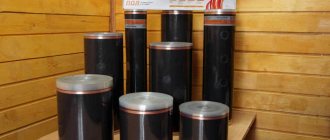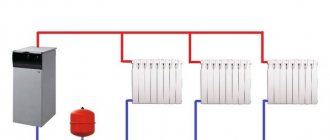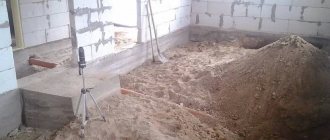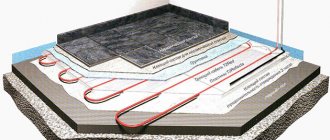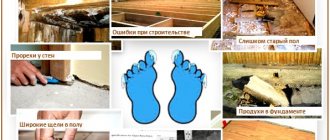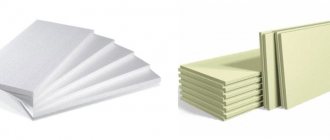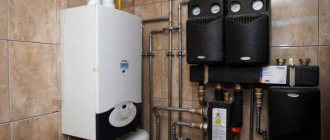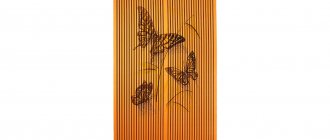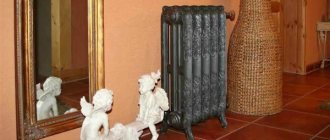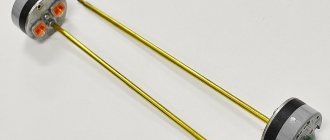Parquet or solid wood and heated floors? Will the parquet withstand the constant temperature changes that occur when the heating is turned on and off?
In Russia, as you know, there is winter for nine months and simply cold for three months. The unpredictable climate of the middle zone will not allow you to relax. And nothing warms the cold northern blood more than a comfortable, beautiful house, insulated according to all the rules of modern construction. Everything can be insulated - walls, roof, floor. A hot topic in city apartments is the installation of heated floors.
Types of suitable heated floors for parquet boards
Considering that the heating system gives an additional temperature load to the coating (in particular, parquet boards), it is important to choose the most suitable type of heated floor. Currently, there are 3 types of heated floors - infrared, electric and water - in order to choose the best option, we will consider each type separately
Infrared systems
Infrared heating systems consist of graphite elements contained in a polymer film. When heated, the elements that make up the composition emit thermal energy in the infrared range, which is transferred to the parquet flooring. When using an infrared heating element in combination with a warm floor, it is undesirable to heat the coating above 28 degrees.
Electrical systems
Electric heating systems operate using heat cables. This heating system is one of the most budget-friendly; conductors in combination with wood covering increase the risk of fire. In this regard, parquet boards for underfloor heating of this type are not recommended for use.
Water systems
Water heating systems consist of plastic pipes containing water that is heated to the required temperature. This system heats the floor evenly and is completely safe, although the possibility of leaks cannot be ruled out. That is why parquet boards for warm water floors are an ideal option.
Kinds
How to make a warm floor from heating Warm water floor. Installation of heated floors
A warm floor is a floor device with thermal insulation that retains heat from heating devices, with the presence of a coolant that actively heats the room.
Types of heated floors:
- A water heated floor is a set of plastic (less often metal) heating pipes, in a frame house, powered by a heating boiler (gas or electric, less often wood), running in a concrete screed under the finished (in our case, parquet board) floor, it can also be installed on a flooring made of heat-insulating material (expanded polystyrene) or on a wooden flooring, in frame houses, the design of which does not imply the use of concrete screed.
- Electric heated floor - also installed in a concrete screed or on a wooden floor with additional electrical insulation. Electric heated floors are widely divided into those created by heating cables (also cable mats or rods on the base), as well as infrared mats consisting of a substrate film, graphite rods and copper (or silver) wire.
Water
Water heated floors are considered the most effective solution when it is necessary to achieve high heating temperatures.
It allows you to save money (as it is cheaper to operate than an electric one) and achieve durability.
It is worth considering that this flooring option:
- not well suited for situational use - when the heating in a frame house is turned off, the water in the pipes will freeze, it is better not to consider it as an option for a house with weekend visits;
- does not go well with a parquet board that is sensitive to moisture, it can become a terrible disaster for it if it starts to leak or a water breakthrough occurs;
- For temperature-sensitive parquet boards, it is also too hot and, moreover, of all types, it is the worst to regulate.
Electric
Electric heated floors are installed using electrical cables.
They are laid parallel or in a spiral into a concrete screed.
In addition, thermomats with smaller cables and a coolant in the form of carbon powder or carbon fiber can be used - this is a fairly good choice when installing a heated floor under a parquet board.
The electric floor is connected to the network through a distributor and can be adjusted in temperature, which allows you to maintain the optimal value in the case of a parquet board (about 21-27 degrees at the surface, which gives from 18 to 21 degrees in the room).
An electric floor also does not additionally affect the humidity of the room, and a well-insulated floor remains safe for wooden structures. The disadvantages, however, include a theoretical fire hazard, as well as the need for serious repairs if the cable is damaged.
Electric heated floors based on infrared mats with graphite rods are considered the most effective solution for combination with parquet boards:
- It is easy to install and connect; it is mounted under a board on a dry screed or other base with thermal and electrical insulation.
- It transfers temperature from the coolant through infrared radiation, which is transmitted not to the screed, but to objects in the room, making heating more uniform and also causing less harm to the floor covering.
- If one of the rods fails, the entire structure is not damaged and continues to function safely.
The disadvantages of this option include relative sensitivity to pressure; mats should not be placed in places where heavy furniture is supposed to be placed.
Please note: electric heated floors are considered optimal for parquet flooring due to the possibility of finer temperature regulation. But in frame houses, where a warm floor becomes the only source of heating, a water floor is installed together with a temperature control system and can also be finely tuned.
Is it possible to put parquet or parquet boards on a warm floor?
We explained why parquet, parquet boards and solid floorboards are not the most suitable types of covering for heated floors. Suitable - ceramic and stone tiles, acceptable - laminate, non-insulated linoleum and low-pile carpet. So, is it possible to put parquet or parquet boards on a warm floor? We answer: it is impossible. But if you really want to, you can. You just need to understand that, firstly, this will negatively affect the efficiency of the heating system. Secondly, such a solution imposes a number of restrictions both on the functioning of the heating system and on the selection and installation of wooden floors. More about this:
Features of installing heated floors under natural wood coverings
To prevent cracks from appearing in parquet or parquet boards during the heating season, the heating of the floor should not be strong. If we remember about formaldehyde, heated floors under parquet boards should not heat up above 26 ºC. But that's not all. Manufacturers of solid parquet and parquet boards claim that in order to avoid deformation of the wood and to preserve its service life, the difference between the temperature of the coating and the air in the room should not exceed 2 ºC. If you adhere to the standard of +18 ºC for residential premises, the floor cannot be heated above 20 ºC. At this temperature, the floors will not feel cold and you can walk on them barefoot. But the heat they generate is not enough to warm the room during the cold season. Of course, if we are talking about Central Russia, and not about Sochi. No, in a super insulated, energy efficient passivehouse with forced recovery ventilation and such a small amount of thermal energy is enough for heating, but how many such buildings have we built? Therefore, in an ordinary house in a room with natural wood floors, the main heating devices should be radiators, and heated floors should only complement them, only slightly warming up the parquet.
A standard mixing module for warm water floors will not be able to provide accurate and smooth temperature control at such low values and in a narrow range. You will need additional equipment: a floor temperature sensor (namely the floor, not the air in the room) and a control valve servomotor.
And don’t forget that wood does not transmit heat well from heating pipes, so you need to increase the thickness of the thermal insulation layer underneath so as not to waste energy and money.
Features of the selection of parquet and plank coverings for heated floors
For heated floors, you should select parquet and parquet boards made from the most stable types of wood. Oak, ash and walnut are best suited. The hornbeam behaves well. It is better not to use exotic species other than teak and iroko. Beech and maple are absolutely not suitable; they are most susceptible to temperature and humidity expansion. It is advisable to use a larch floorboard.
You should choose a parquet board of medium thickness - 13-17 mm. A thin 10mm one may warp, and a thick one will transmit heat worse. It is better to choose parquet with a thickness of 16-18 mm, and a floorboard - 25 mm.
Features of installing parquet flooring over heated floors
If you maintain the above-mentioned temperature conditions for heating floors, you can use any type of wooden floor as a covering: solid parquet and parquet boards, glued multilayer parquet boards, solid floor boards. However, the coating installation technology should be taken into account:
Multilayer parquet boards are laid in a “floating” manner on the substrate without being fixed to the base. There will be no problems with careful installation of this floor; the recommended thickness of the substrate is 2-3 mm.
Solid parquet on a concrete screed should be laid on plywood, which, in turn, must be glued and fixed with dowels to the base. When laying heating pipes, it is necessary to make a very precise diagram of their location and, when drilling holes in the screed for dowels, be very careful not to damage the pipe.
Installation of a floor heating system
When laying a flooring system, you get a kind of multi-layer cake; let’s look at each layer in more detail.
Requirements for the foundation for the structure
The first layer of the cake is a properly prepared base. This can be any overlap that is pre-leveled. SNiPs regulate the absence of significant differences in heights, protrusions and roughness. The wooden floor must be level, without protruding boards.
Each board should be well secured and should not bend. The maximum permissible limit of deviation from the horizontal is 2 mm, distributed over 2 m of area in any of the existing directions.
Construction of the insulating layer
To prevent heat loss, it is necessary to install an insulating layer. The material for its implementation is selected individually, based on operating conditions. It must be moisture-resistant, fire-resistant and compatible with other building materials.
It is desirable that additional sound insulation be provided. If possible, the thinnest but most effective material is selected.
Pipe fixation option
The actual flooring under the pipes is laid on top of the insulation. There are many options here. These can be polystyrene mats with special bosses for pipes. Such mats are produced single and doubled with insulation.
In the latter case, the insulating layer may be superfluous. Sheets of lumber with cut grooves for pipes can be used as flooring. They are also produced industrially. There are also homemade floorings made from slats, bars, etc.
Pipe for moving coolant
Next, the heat pipe is laid into the prepared fasteners and grooves. To ensure a tight fit and create a heat shield, the parts are placed inside a special aluminum profile.
If there is none, you can make similar elements from galvanized steel or wrap each part in thick foil. It is optimal to lay an additional layer of foil on top of the mounted pipes.
Construction of the foundation for finishing
A base must be laid on top of the pipes under the floor covering. It is selected depending on what kind of finishing coating will be laid.
If you plan to install tiles, ceramic or PVC, as well as linoleum or carpet, moisture-resistant plasterboard is laid on the metal elements of the wooden flooring. If polystyrene mats were used to construct the flooring, GVL is laid in two layers.
The decking structure is usually covered with a base for the finishing coating. It is selected depending on the material that is preferred as a coating. For example, a moisture-absorbing substrate is placed under the laminate; moisture-resistant plasterboard or chipboard is placed under the tiles.
Drywall is not laid under laminate on wooden flooring. Instead, foamed polyethylene or a cardboard backing is placed on aluminum plates to absorb excess moisture.
Instead of GVL, you can use moisture-resistant types of chipboard or plywood. A good solution is glass-magnesium sheets, which also conduct heat well, which is absolutely not superfluous when arranging a heated floor.
Choosing a heated floor technology
Before laying a heated floor, you need to decide on its type. It is best to use an electric heated floor under parquet, since in this case there is no danger of damaging the parquet board. When using water heating, in the event of an emergency, for example, a water leak, the parquet may swell and deteriorate.
Scheme of installing a heated floor under parquet.
The work of laying parquet boards itself is quite lengthy, so if there is a problem with the heating system, you will have to remove this covering, which is quite problematic.
It is also of great importance that parquet boards can be considered good insulation materials and, if installed correctly, floor insulation may not be required. But still, if you install a warm floor under parquet, you need to remember that there must be a fireproof coating underneath.
Stages of installation of a warm electric floor
The most modern way to insulate a parquet board is with an electric cable. But in this case there is 1 drawback - fire safety
Because of this, it is important to properly organize insulation. At the first stage of work, the base is cleaned, all irregularities and debris are removed.
You can use putty for leveling. Then a layer of waterproofing compound is applied. Support logs are installed on the base of the floor. They are made at a distance of 50-60 cm from each other. The surface between them is filled with waterproofing materials. You can use penofol or other sheet foam materials.
Installation diagram of an infrared film heated floor under a parquet board.
Roll materials, such as mineral wool, for example, are also widely used. They need to be laid in stripes. Fasten with special glue or overlap them by at least 10 cm. After this, you need to make a finishing floor. For this you will need a parquet board. A galvanized mesh is placed on top. The electrical cable itself, in order to insulate the parquet board, is placed next to the beams at a distance of at least 1 cm from them. Cuts are made in the beams not to the full thickness, about 3 cm wide, foil is laid, and an electric cable is laid on it. The cable is secured using mounting tape. On top of the cable you will need to again make a layer of fireproof material. After this, it is necessary to organize the finishing floor. The warm floor under the board is ready. It is recommended to use plywood or wood-fiber materials (fibreboard) as a base for parquet boards, which are secured using self-tapping screws. In this case, a sheet of plywood 50 x 50 cm must be fixed in 8 places.
The main disadvantages of parquet insulation
As already mentioned, it is not at all necessary to insulate the parquet board. Before doing this, you need to know the possible negative consequences of the work. Firstly, the parquet itself does not allow cold air to pass through, thus, in the presence of a layer of insulation, the performance of the parquet board in heating the room deteriorates. The parquet flooring in the apartment does not require additional thermal insulation. Secondly, if there is a heating layer, the parquet can dry out and crack. Its appearance changes and aesthetics decreases. All this will ultimately require the residents to undergo major repairs, or they will have to periodically seal cracks and putty the floor with their own hands.
Underfloor heating systems are more suitable for tiles than planks. Therefore, it is advisable to insulate the floor in the bathroom, loggia, and toilet. Thirdly, the technical side of the process is also of great importance. In addition to the possibility of emergency situations, there is a possibility of damage to the insulation system itself: pipes or electrical wires. The thing is that the best option for insulating parquet is using plywood, which is attached with self-tapping screws to the screed. In this case, there is a possibility of damage to wires or pipes, and it will be very difficult to find this area. An alternative to perquet is laminate.
Arguments against"
Opponents of using this type of finishing in conjunction with underfloor heating systems cite the characteristics of the boards as the main argument: very low thermal conductivity and, as a consequence, the inability to properly warm up the wood layer. Therefore, it is pointless to lay a heated floor under a parquet strip - the efficiency of the structure will be practically zero.
In addition, when heated, the wood will expand and deform, which will inevitably lead to various kinds of problems: the appearance of cracks, creaking dies, and so on. There will be a need to constantly monitor the condition of the coating and permanently correct emerging defects. At the same time, wood itself is already an excellent heat-saving material that does not require additional heating.
The last compelling argument will be the need to use plywood as a base for laying parquet. It will have to be attached to the floor using self-tapping screws, and at the same time, there is a risk of damaging the heating circuit, even if the parquet board for a warm water or electric floor is mounted on top of a concrete screed - it is into it that the screws securing the plywood base will be screwed.
Features of heating such a floor
To summarize, there is only one feature - caution. The maximum water temperature should not exceed 50 degrees
But the lower surface of the tree should not heat up by more than 40 degrees.
The above parameters are very easily controlled by the equipment included in the heated floor, and, on the contrary, in a situation of heating with electricity, it is very difficult to adhere to them. Therefore, parquet is better suited for a water floor heating system.
Experts who study parquet flooring have long noticed that under more or less traditional conditions of our climate in winter, gaps will be clearly visible between parquet floorboards, which will disappear in the warm summer. This is also the result of temperature fluctuations, which causes humidity levels to fluctuate.
If you want to minimize gaps, you should lay planks of the minimum width.
Answering the question about the advisability of using parquet for warm water floors, let’s say that it is quite possible and even effective. If you follow certain rules, everything will work out for the best.
Recommendations for carrying out work
Since the price of materials is high, as are the costs of underfloor heating, it is important to do everything correctly and choose the optimal materials. . Types of heating systems
Types of heating systems
First, let's figure out which warm floor under a parquet board is better, there are three main options on the market, we'll tell you more about each of them:
- Electrical systems are distinguished by factors such as low price and a fairly simple installation process (although there are certain nuances). But they have one property, which is a big disadvantage when using boards - the heating rate is too high, and as you know, sudden temperature changes cause cracks to appear on the surface, which is why this solution is the least preferable;
Electric underfloor heating is not suitable for our case
- Infrared systems are distinguished by the fact that they heat not the air, but all surrounding objects, their advantage is simple installation instructions, doing it yourself is as easy as shelling pears - you just need to lay out the sheets and connect power to them, the board can be laid directly on the surface. This solution is well suited in our case, since the nature of its operation implies a less aggressive effect on the material;
This option is good because the board can be placed directly on the film
- Water systems are the most difficult to install, but their properties and performance are much better than other options. This is why parquet boards are best suited for warm water floors; the main reason is that it heats up very slowly, which ensures minimal negative impact on the material, and a constant temperature is most often maintained during operation.
Water-heated floors under wooden boards also work very well
Laying parquet on heated floors - all the pros and cons
Professional builders and finishers still cannot come to a consensus on whether warm flooring under parquet boards is an acceptable option.
Each side has its own compelling arguments for and against laying natural wood flooring on a warm floor.
"Against"
First, let's look at the arguments of those who are categorically against the use of parquet boards for heated floors.
- Poor thermal conductivity. Due to the fact that natural wood has a low thermal conductivity coefficient, the transfer of thermal energy from the heating elements to the air in the room will be significantly hampered. Accordingly, heated floors will lose one of their main advantages: higher efficiency compared to wall-mounted radiators. To maintain a comfortable temperature in the room, you will have to heat electrical wires or coolant fluid to higher temperatures. The cost-effectiveness and efficiency of ultra-modern heated floors will eventually be on par with the centuries-old “classics” - hanging heating radiators. The underlay for the parquet board, which is an integral element when installing the flooring, will only worsen the situation.
When regularly exposed to high temperatures, wood can become deformed.
The next argument against is related to the operational features of natural wood. Using a parquet board as a conductor of thermal energy can negatively affect its condition. Under the influence of regular temperature changes, even a well-installed coating can soon take on an unpresentable appearance. Dry, creaking floorboards, cracks and deformation of wood, peeling varnish are possible consequences of exposure to high temperatures. For a warm water floor, there is another argument against laying parquet boards over it. It's all about the coolant circulating through plastic pipes. Despite years of warranty from hydronic flooring manufacturers, there is a possibility of water breaks or leaks. As a result of such, even purely hypothetical, accidents, your expensive flooring may become unusable: the fungus and rot that multiply underneath it will quickly do their job. For more information about using parquet on heated floors, watch this video:
However, in spite of everything, a number of experts consider laying parquet boards over warm floors to be completely acceptable. To do this, you just need to follow certain rules and recommendations.
- Uniform heating of the entire surface of the floor covering. The ideal option that allows you to combine parquet and warm floors without conflict is IR heating elements. Infrared heated flooring under the parquet board ensures the most uniform heating of all floorboards. As a result, the risk of joint cracking or wood deformation is minimized.
- You should not purchase parquet boards made of natural maple and beech for laying warm floors. Their wood is very sensitive to temperature changes, which causes its deformation and cracking.
- The optimal thickness of the parquet board is 12 mm. Thinner options will become unusable too quickly under the influence of temperature changes, and too thick parquet will create an unnecessary obstacle to heat circulation.
- A damper tape should be secured along the perimeter of the walls at the level of the flooring. It will play the role of a shock absorber during the compression and expansion of parquet under the influence of temperature changes. For the same purpose, parquet should be laid in a “floating” version without a rigid connection to the base of the floors.
- Recently, special varieties have appeared on the construction market that can be combined with underfloor heating systems. They have individual markings, as well as recommendations for their operating mode.
Under no circumstances should you use self-tapping screws or dowel nails: the likelihood of damaging the water pipes or power cable embedded in the screed is too high. For more information about laying parquet on a film floor, watch this video:
Having become familiar with the features of parquet flooring and underfloor heating systems, each owner can independently weigh the pros and cons, choosing the option that suits him best.
You need to weigh everything carefully
Walking on a cold floor is not very pleasant, especially in winter. Therefore, carpets are laid in the rooms, and residents use slippers. But this does not apply to wood flooring, including parquet. The wood itself is warm enough, so walking on it barefoot does not feel any discomfort.
There are some reasons why experts do not recommend installing heated floors under parquet. Let's list some of them.
- Due to the thermal insulating properties of natural parquet, heating it may be pointless, since the wood simply will not allow some of the heat to pass through.
- Exposing your hardwood floors to high temperatures can lead to several problems. Due to the appearance of gaps between the tiles, the floor will lose its visual appeal and begin to creak. Permanent repairs will require physical and material costs.
The conclusion suggests itself. Before making the final decision on installing a heated floor under parquet, you will need to take into account many factors, make the necessary calculations and consult with a professional.
Today, there are two main types of heated floors: electric, in the form of cable, heating mats or film, and water, which is a pipeline that connects to central heating. Once you have decided on the type of heating system, it is time to choose the flooring
And here it is important not to make a mistake.
Not every type of laminate, let alone parquet, is compatible with heated floors. Natural wood reacts poorly to temperature changes, drying out, cracking and deforming. Laminate that is not intended for heated floors, even if it does not lose its presentation, may not heat up well or emit harmful substances
That is why you need to pay attention to the question of which laminate to choose for a warm floor. The same goes for parquet
Manufacturers produce collections of coatings created specifically for installation over floor heating systems. You can find the appropriate markings on the packaging. In addition, the manufacturer indicates technical characteristics, which also need to be taken into account. It’s better if a knowledgeable person helps you choose a combination of heated floors and coverings.
It doesn’t matter what you choose - a solid board for a warm floor or a laminate for a warm water floor. The Decoracion studio will definitely help you find a suitable option that combines both aesthetics and functionality. With us you can be sure of the quality, safety and reliability of parquet and laminate flooring.
Why this particular parquet board?
- This board has the best varnish resistance to abrasion
- Automated system for cutting, preparing wood and detecting defects.
- This, like almost everything we use, is an environmentally friendly material.
- The board is covered with 7 layers, this is another plus in its piggy bank against deformation
- There is nothing more beautiful than natural wood
- The parquet board can be re-scraped several times, so it will serve you until you get tired of it.
Installation of a water floor
A water-based floor is a good solution that is often adopted when it is necessary to lay a wooden floor. Thanks to this, heating the room occurs without problems, and an additional heating system is not required. The advantages of systems of this type:
- a minimum amount of electricity is consumed;
- they are safe and environmentally friendly;
- the base heats up evenly.
However, water heating elements also have their disadvantages. It’s also worth learning more about them:
- temperature control is much easier than with infrared or electric floors;
- in the process of laying plastic pipes, the floor level rises by 10 cm;
- when laying a water floor, it is impossible to completely eliminate leaks;
Due to the disadvantages of a water floor, it should not be installed in apartments of multi-storey buildings. If a leak occurs, several problems will arise - the coating material will warp and the wiring will short out.
Underfloor heating systems
To understand how compatible warm floors and parquet boards are, you should take a closer look at their design and operational features.
Underfloor heating is attractive, first of all, due to the possibility of uniform heating of the room. Unlike classic heating radiators placed on the wall, heated floors create the most comfortable temperature in the lower half of the room, that is, in the area where residents are usually located.
In the case of wall-mounted radiators, the air heated by them first rises to the ceiling, and only then begins to spread to the bottom. In this regard, the efficiency of underfloor heating systems is much higher.
Today there are three main types of heated floors on sale:
Each of these systems has its own characteristics, advantages and disadvantages.
Water floors
The heat source in this case is the heated coolant. The entire heating structure consists of a hot water boiler, from which the coolant is circulated through a system of pipes laid under the floor covering.
Most often, flexible plastic is used as a material for pipes. Such pipes, unlike metal ones, are easily deformed under external influence, which can create obstacles to the normal circulation of the coolant.
Therefore, after installation, water floors are filled with cement screed, which plays not only the role of protection from external physical influence, but also a heat conductor.
Cable and infrared film floors
This type of underfloor heating uses electricity as a source of thermal energy. True, there are significant differences in their design and operation.
Cable floors are electrical wires enclosed in an insulating braid and which, when exposed to current, begin to heat up. From them, heat is transferred to surrounding objects, primarily to the floor covering.
For the same reasons as water floors, cable floors are poured into a concrete screed, which serves as “armor” and increases the efficiency of the heating system.
Film floors also run on electricity, but infrared radiation is used to transfer heat. Special graphite heating elements, enclosed in a protective film, convert electricity into infrared radiation. Through infrared rays, heat from film floors is transferred to surrounding surfaces.
Due to this peculiarity of operation, IR floors are not embedded in a concrete screed. In this case, it can only be used as a leveling base.
As you can see, all underfloor heating systems, regardless of their design features, have one main common feature: the floor covering is initially heated, from which the thermal energy is transferred to the surrounding air.
It is in this context that the compatibility of parquet and heated floors should be examined.
Features of the flooring system
The traditional version of a water-type floor involves installing pipes in a screed. It is poured with a concrete solution with special additives that increase its thermal conductivity.
As a result, the concrete pad becomes a kind of heat accumulator, which makes it possible to use such heating as efficiently as possible. However, the traditional arrangement method has disadvantages.
The wooden base has low thermal inertia, which prevents the system from functioning normally. To correct this drawback, heat-reflecting plates are installed from metal with high thermal conductivity.
The most obvious is too much weight of the concrete screed. With a solution density of about 2000 kg/sq. m it gives a significant additional load on the base and load-bearing structures.
For reinforced concrete slabs, such a load is quite feasible. For wooden floors - prohibitive. For this reason, the traditional installation method is prohibited in such cases. The so-called flooring system is used here.
It is made in the form of a low flooring, inside of which pipes are located. Wood is most often used for its arrangement, but industrially produced polystyrene flooring has appeared relatively recently.
The pipes are placed in grooves where they are secured. It is known that wood conducts heat very poorly. For this reason, wooden systems cannot be an effective source of heat.
To correct this deficiency, metal heat-conducting elements are inserted into each groove. They also strengthen the structure. There are similar details in polystyrene flooring with metal inserts, the material of which is also a poor heat conductor. In this way, a reliable and durable heating system is assembled.
Its advantages over its traditional analogue can be considered:
- Light weight of the flooring, which even wooden floors can withstand.
- Relatively simple assembly, especially when it comes to industrial flooring models.
- There is no need to wait for the concrete screed to harden. Finishing work can be done immediately after installation.
- Full maintainability. To carry out repair work, it is enough to lift a fragment of the flooring to provide access to the area with the fault.
Another undeniable advantage of the flooring system is its versatility, which makes it possible to implement a variety of modifications. Most of which are homemade. The main disadvantage of the flooring scheme is rapid cooling. The floor heats up in a short time and gives off heat just as quickly.
A big plus of a water-based floor is the possibility of relatively simple repairs. To get to the damaged fragment, it is enough to remove a section of the floor covering and remove the flooring underneath it
Actually, the heat supply is limited to that which is in the coolant liquid in the pipes. Therefore, when the boiler is stopped, the room will soon cool down. For this reason, deck systems are more often used as an addition to the main heating system, especially in cold regions.
Which heated floor to choose for parquet and parquet boards
Water heating
This system is a network of polymer pipes through which hot water supplied from a boiler or central water supply system circulates. A screed is poured on top, on top of which the finishing coating is laid. It is a contact heating system, i.e. The coolant, passing through the heating circuit, gives off its heat to the screed, which in turn heats the floor covering. This system is quite complex and expensive to install. In the event of a failure, locating and repairing the fault is not an easy task. The use of such a system in apartment buildings is prohibited (clause 11.9 of Moscow Government Decree No. 508-PP dated October 25, 2011).
Why wood flooring is not suitable for heated floors
There is no worse covering for heated floors than natural wood. No matter how you look at it, this solution has some disadvantages. Let's look at the problem from two points of view: heating and finishing.
Heating problem
The entire structure of a heated floor in a room: pipes with coolant circulating through them, a concrete screed or a lath or flooring system that replaces it, and a coating - this is one large heating device
For a heating device, it is important that the maximum possible part of the thermal energy enters the room without encountering obstacles along the way. The cast iron battery releases heat to the environment without any problems
Also, a warm floor, where the pipes are filled with a layer of concrete about 4 cm thick, and ceramic tiles are laid on top, transfers thermal energy well into the room. This is because metal, concrete and ceramics have high thermal conductivity.
You can conduct an experiment: in winter, wrap a radiator located in a room under a window in a warm blanket. After a while we will feel that the room has become noticeably colder. The blanket prevents heat transfer; the coolant returns to the system at almost the same temperature as it entered the battery. If we wrap all the radiators in the house in blankets, the rooms will become cold, and the boiler may overheat.
Natural wood has low heat transfer and acts like a blanket, reducing heating efficiency. In addition, thermal energy, encountering an obstacle to its spread from above, will tend downwards into the ceiling or subfloor. In order not to lose a significant part of the heat, you will have to additionally insulate the floor structure from below. And these are financial costs and reducing the height of the room due to increasing the thickness of the insulation. The above indicates that using natural wood for underfloor heating is not economically feasible.
Coating problem
Natural wood is a “living” finishing material. Wood fibers easily absorb and release moisture, and the geometric dimensions of the products noticeably change. Wet wood swells; when it loses moisture, it shrinks; the changes are especially great across the grain. The relative air humidity in the room in summer is 40-65%; at these values, wooden furniture and floors “feel” good. During the heating season, with radiator heating and the absence of humidifiers, humidity can drop to 20-35% or lower. At the same time, wooden floors dry out: gaps appear between the parquet floors and the closer to the radiators, the wider the gaps in the floor. Let's imagine that the entire floor is a large radiator, constantly heating the entire surface of the wooden floor. Under the influence of heat, the wood will dry out, the parquet flooring or boards will decrease in size and noticeable gaps will appear between them over the entire surface area. The higher the temperature of the heated floor, the more the wood will dry out over the winter.
A multilayer parquet board will behave a little more stable. Due to the fact that it consists of several layers of wood, the fibers of which are located perpendicularly, the humidity-temperature deformations of glued parquet boards are not as great as those of solid parquet and floorboards.
But here a different danger awaits the consumer. When making parquet boards, glue containing formaldehyde is used. Up to a temperature of 26 ºC it is bound in glue and the parquet board is safe. When the specified temperature is exceeded, harmful formaldehyde vapors begin to be released and enter the air. At the same time, the operating temperature of the coolant in the heated water floor system, which is provided by standard equipment, is 40ºC. The floor surface can heat up to 35 ºC.
What is a parquet board?
Parquet board is a relatively new type of coating used as an alternative to parquet.
This type of board has the following advantages:
- environmentally friendly, contains natural wood;
- ease of installation/disassembly, the board is sold already processed and there is no need to carry out additional preparation of the material before installation, which saves time spent on installation, and a convenient locking connection simplifies the installation technology;
- if necessary, flooring made from parquet boards can be easily dismantled without damaging the material itself; after dismantling, the parquet board can be reused;
- Possibility of operation immediately after installation; after the parquet board covering has been installed, it can be used immediately because it does not require additional work - coating with oil, varnish, etc.;
- price, the advantages of this material include a relatively low price;
- presentable appearance, thanks to its presentable appearance, the parquet board will look advantageous in any room;
But in addition to the advantages, this material also has disadvantages that are important to consider:
reduced moisture resistance, this material is not moisture resistant - therefore, when carrying out installation work, special attention must be paid to protection from moisture; claim of material delamination, during improper operation or installation there is a risk of material delamination, which will certainly negatively affect the appearance of the coating and the room as a whole; increased requirements for the base surface, a prerequisite for laying parquet boards is a perfectly flat surface.
Sequence of work on a wooden base
As already noted, now most developers provide heated floors immediately during the construction of a house. Thanks to them, real estate can always be sold more profitably, and the buyer will be sure that he will definitely not freeze in his new home. But people don’t always buy ready-made houses, but try to build them themselves whenever possible. Everyone understands perfectly well that it works out cheaper, and it’s easier to correct your own mistakes than other people’s.
Wooden buildings require special attention, as wood is highly susceptible to shrinkage. This applies not only to the frame of the house, but also to its internal lining, which after a year becomes not so attractive: cracks appear from which it blows, and in some places there are cracks.
But before these gaps did not exist
Often, only then does the owner begin to think about installing heated floors. But there is furniture on them, and disassembling the covering to get to the joists is too labor-intensive work. How to get out of this situation?
Analysis of the “flight” step by step
We propose to consider this situation in more detail, using a specific example as a basis.
Table. Step-by-step installation instructions.
| Steps, photo | A comment |
Step 1 - removing the baseboard | In addition to the fact that, if possible, the room will have to be cleared of furniture, the first thing to do is to remove the baseboards. Even if the joints between the walls and the floor were properly sealed at one time, as a result of shrinkage processes one hundred percent solid gaps formed under the baseboards. Your task is to seal them thoroughly with polyurethane foam. |
Step 2 - removing the old paint coating | If there is a paint coating on the floor, which was previously finished and will now be rough, it is better to remove it using a grinding or scraping machine. Removing the paintwork will make it possible to apply a fire-retardant composition. |
Step 3 – application of bioprotective primer | We must try to make the treatment so that the soil not only saturates the board well from above, but also flows into the joints. If it is not possible to use a spray bottle for this purpose, apply the composition with a roller and brush on hard-to-reach areas. There should be at least two layers, and preferably three. Each one should be allowed to dry completely. Drying time is determined by the manufacturer's instructions. |
Step 4 – sealing the cracks | At the next stage, you will have to crawl along the floor and manually use a narrow steel or rubber spatula to seal all the cracks between the boards with putty. You can also use one of the newfangled polymer wood sealants that come in tubes that fit a nail gun. |
Step 5 - purchasing boards for constructing contours | While the putty dries, you can go shopping for a planed board, since this is the option for constructing the contours that was chosen in this case. The width of the lumber will provide the required distance between the underfloor heating pipes. In this case, it is 145 mm, the thickness of the board is 20 mm. |
Step 6 - cut the boards | To fix the boards to the base, you also need to purchase self-tapping screws. They did not install insulation under them here, since it is inside the old structure, and the cracks are now well sealed. Advice! In front of you should be a floor laying diagram with marked dimensions, according to which the board is cut. |
Step 7 - rounding the end | To prevent creases from forming in the loops when laying the pipe, which must be solid, the ends of the boards must be rounded. Using any round object at hand, apply a pencil marking, and then make a cut along it with a jigsaw. Advice! It takes too long to tinker with hand tools, so if there is a large volume of work, you need to make sure you have an electric one. |
Step 8 - Ensure Clearance | There should be a gap between the boards, inside which the tubes can be laid. Their diameter is 16 mm, so the groove width must be at least 20 mm. Since the thickness of the board exactly corresponds to this value, its trim is simply used as a template. |
Step 9 - mounting the board | The direction of installation of the board must correspond to the pipe laying pattern (spiral, snake, snail, etc.) that is taken as the basis. |
Step 10 - laying the pipe circuit | This wooden structure also needs to be opened with a protective compound - only now hydrophobic, after which you can begin laying the pipe in the prepared grooves. It should be solid along the entire contour. |
Step 11 – preparation of chipboard | The top of the entire structure will be covered by chipboard – in this case tongue-and-groove, Kwik Dec brand. The underfloor heating pipes are well recessed into the grooves, but the main heating pipes protrude slightly above the surface. Therefore, in order to hide them too, it was decided to make corresponding grooves on the back side of the covering. |
Step 12 – installation of the reflective layer | But first, the wooden base of the floor is covered with strips of foil. The owner refused metal plates for the banal reason of their high cost. |
Step 13 - installation of the top hard covering | As already mentioned, the top layer of the floor cake must be hard. To reduce the cost of installing another layer, for example, a laminate on top of plywood, you can take not just tongue-and-groove chipboards, but the same Quick Dec, only with an improved front surface. As an option, albeit more expensive, it can be cork boards with digital printing Corkstyle, which we see in the photo. In a situation such as the one that served us as an example in this instruction, the option with modular slabs with an ennobled front surface seems to be the most optimal both in terms of labor intensity and cost. |
Despite the fact that the process of installing heating circuits on a wooden base is quite labor-intensive, it is still not as dirty and dusty as the option with a cement screed. And in general, it is undesirable to use wet technologies where structures have a high degree of hygroscopicity. Therefore, when it comes to making such floors in a wooden house that is in use, most people prefer the dry installation method.
Video - Water-heated floor on a wooden base
Video - Installation of water heated floor
Primary requirements
If it has been decided to lay a wooden covering on a warm floor, then, in order to avoid possible problems, the following number of features of this combination should be taken into account:
- The most suitable type of parquet for laying on a warm floor is parquet boards, since this floor covering is better able to withstand changes in humidity and temperature than others.
- To prevent the board from drying out too much when heated, its factory humidity should not be higher than 6..7%.
- It is best to choose a board with the smallest possible width of the plank, because the size of the gap, all other things being equal, is directly proportional to the transverse size of the plank.
- Parquet boards on a warm water floor must be laid either by professionals, or at least under their direct supervision.
- The maximum permissible temperature of the parquet surface is 26°C, and it is strictly not recommended to exceed it. Any excess can cause drying out and deformation of the parquet planks.
- Any change in floor temperature during its operation should be gradual.
- When using a warm water floor system, a waterproofing layer should be installed.
- When choosing a parquet board, you should focus on one that is made from wood that is resistant to deformation. The most commonly used wood is oak. At the same time, maple or beech wood is the most undesirable choice, since these are the species that are most sensitive to changes in humidity levels.
- To prevent humidity levels from falling below 40%, use a humidifier.
laying parquet boards on heated floors
What to pay attention to
Choosing a storage water heater boiler
Not every tree can withstand heated floors. The main reason is a change in the original dimensions of parquet blocks or boards under the influence of moisture when the temperature changes. It's no secret that wood perfectly absorbs moisture and swells, but when it dries out, it shrinks in size and cracks. Therefore, it is recommended to install warm floors under parquet as a last resort, and the covering should be made of wood that has a low deformation coefficient and has high water-repellent properties. Experts offer the following list:
- merbau;
- doussia;
- Iroko.
You should not use beech or maple - they are prone to deformation when the microclimate in the room changes.
The parquet should be heated carefully, gradually raising the temperature on the floor surface
It is important to remember that overheating can lead to negative consequences, so installing thermostats for control is simply necessary here. Of course, in winter, gaps may appear between the parquet boards, which disappear in summer.
To avoid them being too conspicuous, it is recommended to choose:
- parquet thickness no more than 1.5 cm;
- parquet board of minimum width;
- the most elastic glue (polyurethane).
It should be noted that a three-layer parquet board laid on a warm floor behaves a little better. Its structure, namely layers laid perpendicular to each other, does not allow gaps to appear on the surface. In addition, parquet boards are laid using the “floating” method without fixing to the base, and are connected using a tongue-and-groove locking system. This coating can change its size without causing cracks. But do not forget that low-quality cheap parquet boards can delaminate under the influence of frequent temperature changes.
Since the surface of the parquet is not allowed to heat up too much, it is recommended to use additional heating sources in the room. They can be small radiators, including infrared ones, or warm walls.
Choosing a heated floor for parquet boards
Without going into much detail regarding the organization of heating using electric cables or pipes with hot water as a coolant, we only note that both options have found application in repair, construction and design solutions.
At the same time, organizing electric heating is cheaper in terms of work and materials, while water heating can use different types of fuel and is cheaper to operate.
Electric heating is more often used to solve local problems in individual rooms, while water heating is mainly used for heating houses with their own heating system or for heating large objects.
As a rule, underfloor heating systems are used to heat cold floor coverings: tiles, porcelain stoneware, laminate, linoleum. However, if you decide to install parquet or solid oak floors, please read the following guidelines. Wood, as you know, does not have thermal conductivity, and by laying parquet or boards on a warm floor, you reduce the efficiency of the heating system.
Another possible option is to install plywood with two-component polyurethane adhesive. When using it, you can do without screws. But this will not prevent your parquet from drying out. If you nevertheless decide to lay parquet or solid wood on heated floors, then it is advisable that the wooden flooring at the time of installation have a humidity level of 8+_2%. It is recommended to use the most stable types of wood with a cut close to radial.
It is advisable to use oil as a finishing coating on heated floors. It does not cause ruptures in the coating layer when the dies move, and has a higher permissible operating temperature on heated floors. Oil has a large range of colors for tinting floors, provides the possibility of local repairs and a faster, compared to varnish, complete renewal of the finishing layer.
If the finishing of parquet or terrace boards is carried out in production conditions, the use of oil is less labor-intensive and requires less time. The use of parquet with chamfers and a factory-applied oil coating will allow, by avoiding grinding and applying oil on site, to reduce the time required to complete the work. In this case, it becomes possible to apply oil to the end sides of the laying elements, which provides increased moisture protection of the parquet during operation, including in the presence of gaps between the planks.
Less wear resistance of oil coatings will require more painstaking and frequent maintenance and reapplication, which, at the same time, is not a particularly difficult and expensive factor
Heating system on a lightweight rack base
If the system is installed on the surface of an old floor, the latter must be thoroughly inspected and, if necessary, repaired. Each of the floorboards should be lifted and checked in what condition the joists are. Worn or damaged structural elements should be replaced or restored. Sometimes wooden beams are nailed to the floor beams, and insulation is often laid.
For this purpose, you can use polyethylene, which is laid overlapping. When laying to the walls along the perimeter of the entire floor covering, it is necessary to attach a damper tape, the width of which should be about 5 cm. The most convenient method of laying pipes for a heated floor that has a water circuit is a “snake”.
Before starting work, a floor plan is drawn, where the exact location of the pipes is indicated, as well as the installation location of the control equipment. The location of the guides should be marked on the plan and the required gaps should be indicated, the value of which, as a rule, ranges from 0.15 m to 0.3 m. When laying, it is most convenient to use corrugated pipes Ø 16 mm. The slats are manufactured based on the dimensions required in each specific situation.
The heated floor is laid along logs. When installing guides, channels are left between them for installing the pipeline.
It is convenient to strengthen the guides to the rough base using self-tapping screws. In places where pipes are bent, the corners of the strips must be rounded. Foil with a thickness of 50 microns or more is placed in the prepared grooves. You can use a stapler to secure it. Then, the heating system pipes are laid into the channels formed in this way. When fastening formed blocks, you can use pre-prepared metal plates.
After installation of the system is completed, it is necessary to connect it to the heating pipes and perform pressure testing of all existing joints. Once you have ensured that the underfloor heating system is functioning properly, you can proceed to installing the selected finish. When laying the substrate, it is better to use DSP boards that do not contain formaldehyde.
Thus, you are convinced that a warm water floor can be installed on your own over the surface of a wood floor. The implementation of these works is facilitated by the possibility of using slats or ready-made modules during the installation process.
The techniques described in the article are presented visually in the following video:
Warm floors for parquet and parquet boards
Parquet is a floor covering with a thickness of 15 to 22 mm, made entirely of natural wood. Parquet is not a finished product, so after installation it is sanded and varnished. With careful use, the average service life of piece parquet is more than 50 years.
Parquet board is a wooden floor covering made by gluing together several layers of wooden planks. The bottom layer is stabilizing, made of coniferous wood. The load-bearing middle layer is also made of coniferous wood. The top layer is decorative, made of valuable wood. The top of the parquet board is protected with varnish or impregnated with oil. The total thickness of the parquet board is 14 mm, while the thickness of the top layer does not exceed 4 mm. The average service life of a parquet board, subject to operating rules and updating the varnish every 4-5 years, is 15-20 years.

